Related Research Articles

The 11th Armored Cavalry Regiment is a unit of the United States Army garrisoned at the Fort Irwin National Training Center in California. Although termed an armored cavalry regiment, it is being re-organized as a multi-component heavy brigade combat team. The regiment has served in the Philippine–American War, the Pancho Villa Expedition, World War II, the Vietnam War, Gulf War and Iraq War. The 11th ACR serves as the opposing force (OPFOR) for the Army and Marine task forces, and foreign military forces that train at Fort Irwin.

Adna Romanza Chaffee Jr. was an officer in the United States Army, called the "Father of the Armored Force" for his role in developing the U.S. Army's tank forces.

The Battle of 73 Easting was fought on 26 February 1991, during the Gulf War, between Coalition armored forces and Iraqi armored forces. It was named for a UTM north–south coordinate line that was used as a phase line by Coalition forces to measure their progress through the desert. The battle was later described by Lt. John Mecca, a participant, as "the last great tank battle of the 20th century." This battle took place several hours after another, smaller, tank battle at Al Busayyah.

The United States Cavalry, or U.S. Cavalry, was the designation of the mounted force of the United States Army. The United States Cavalry was formally created by an act of Congress on 3 August 1861 and ceased as a distinct Army branch in 1942. The name "cavalry" continues to be used as a designation for various specific United States Army formations and functions.

The 1st Cavalry Regiment is a United States Army regiment that has its antecedents in the early 19th century in the formation of the United States Regiment of Dragoons. To this day, the unit's special designation is "First Regiment of Dragoons". While they were the First Regiment of Dragoons another unit designated the 1st Cavalry Regiment was formed in 1855 and in 1861 was re-designated as the 4th Cavalry Regiment. The First Dragoons became the 1st Cavalry Regiment since they were the oldest mounted regiment.
Reconnaissance, surveillance, and target acquisition (RSTA) refers to a joint doctrine of reconnaissance, surveillance and target acquisition conducted by the United States Armed Forces. RSTA operations are designed to support military operations at a strategic, operational, or tactical level, either by dedicated RSTA forces or those which possess the capability.
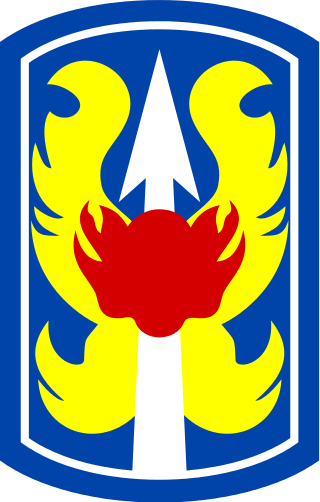
The 199th Infantry Brigade (Light) is a unit of the United States Army which served in the Army Reserve from 1921 to 1940, in the active army from 1966 to 1970 (serving in the Vietnam War), briefly in 1991–1992 at Fort Lewis, and from 2007 as an active army training formation at Fort Moore.
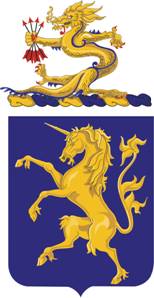
The 6th Cavalry is a regiment of the United States Army that began as a regiment of cavalry in the American Civil War. It currently is organized into aviation squadrons that are assigned to several different combat aviation brigades.
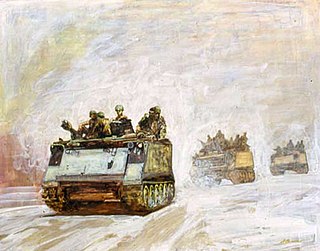
Armoured cavalry are combat units using armoured fighting vehicles (AFVs) instead of horses. They began to replace horse cavalry in the heavy shock and the light reconnaissance, skirmishing and exploitation/pursuit roles in most armies commencing after the First World War.

The 194th Armored Brigade is a separate brigade of the US Army. All armor, cavalry, and armor and cavalry mechanic soldiers, and Marines in equivalent specialties, are trained by the 194th under the armor component of the Maneuver Center of Excellence at Fort Moore, Georgia, where the 194th has been garrisoned since 2012.
A combat command was a combined-arms military organization of comparable size to a brigade or regiment employed by armored forces of the United States Army from 1942 until 1963. The structure of combat commands was task-organized and so the forces assigned to a combat command often varied from mission to mission.

The 13th Cavalry Regiment is a unit of the United States Army. The 2nd Squadron is currently stationed at Fort Bliss, Texas, as part of the 3rd Armored Brigade Combat Team, 1st Armored Division.

The 15th Cavalry Regiment is a cavalry regiment of the United States Army. It was one of the Expansion Units originally established for the Spanish–American War, but has been a general workhorse unit ever since.

The 197th Infantry Brigade is an active Infantry brigade of the United States Army. The brigade was active as an Organized Reserve unit from 1921 to 1942, in the Regular Army from 1962 to 1991, and as a TRADOC training unit from 2007 to 2013. The brigade saw service in Operation Desert Storm with the 24th Infantry Division. On July 31, 2020, the brigade was activated as a training brigade in Fort Moore, Georgia, to serve the increased training needs of the army.
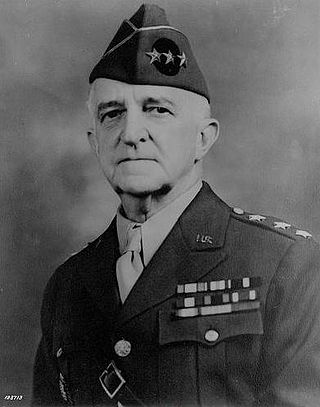
Daniel Van Voorhis was a United States Army lieutenant general and was noteworthy for his assignments as commander of V Corps and the Caribbean Defense Command, as well as his efforts in creating the Army's modern armor branch.
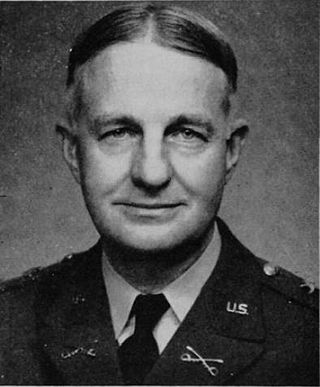
John Knowles Herr was a career American soldier. Herr served for 40 years in the United States Cavalry and participated in the final battles of World War I as chief of staff of the 30th Division, but is best remembered for being the last Chief of U.S. Cavalry. In March 1938 Major General Herr was appointed Chief of Cavalry and became a fierce advocate of traditional horse cavalry troops. He defended cavalry as an independent branch of service and opposed conversion of mounted troops into mechanized or armored units. Herr's affection to horse, "somewhat quixotic" for the period, temporarily made him "a hero and a standard bearer" to generations of officers indoctrinated in cavalry tactics.

The 33rd Armor Regiment was an armored regiment in the United States Army first formed in 1941. In 2005, the 33rd Armor was redesignated 33rd Cavalry Regiment. The 1st Squadron, 33rd Cavalry Regiment, a part of the 3rd Brigade Combat Team, 101st Airborne Division, carries on the lineage of 33rd Armor Regiment.

The 34th Armor Regiment is an armored regiment of the United States Army formed in 1941.

The 2nd Squadron, 107th Cavalry Regiment is a cavalry squadron of the 37th Infantry Brigade Combat Team and the Ohio National Guard located throughout southwest Ohio.

The 124th Cavalry Regiment is a United States Army cavalry regiment, represented in the Texas Army National Guard by 1st Squadron, 124th Cavalry, part of the 56th Infantry Brigade Combat Team at Waco.
References
- ↑ Worth, Greg (2005). 1st Armored Division: WWII & Beyond. Kentucky: Turner Publishing Company. p. 10. ISBN 1-59652-011-6.